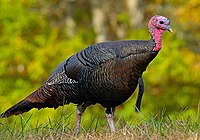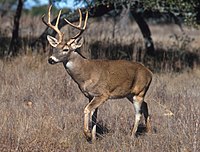
Using satellite‐derived estimates of plant phenological rhythms to predict sage‐grouse nesting chronology
Sign Up to like & getrecommendations! Published in 2020 at "Ecology and Evolution"
DOI: 10.1002/ece3.6758
Abstract: Abstract The “green wave” hypothesis posits that during spring consumers track spatial gradients in emergent vegetation and associated foraging opportunities. This idea has largely been invoked to explain animal migration patterns, yet the general phenomenon… read more here.
Keywords: chronology; sage grouse; sage; green wave ... See more keywords

Predicting greater sage‐grouse habitat selection at the southern periphery of their range
Sign Up to like & getrecommendations! Published in 2020 at "Ecology and Evolution"
DOI: 10.1002/ece3.6950
Abstract: Abstract Mapping suitable habitat is an important process in wildlife conservation planning. Species distribution reflects habitat selection processes occurring across multiple spatio‐temporal scales. Because habitat selection may be driven by different factors at different scales,… read more here.
Keywords: sage grouse; habitat selection; selection; range ... See more keywords

Greater sage‐grouse respond positively to intensive post‐fire restoration treatments
Sign Up to like & getrecommendations! Published in 2022 at "Ecology and Evolution"
DOI: 10.1002/ece3.8671
Abstract: Abstract Habitat loss is the most prevalent threat to biodiversity in North America. One of the most threatened landscapes in the United States is the sagebrush (Artemisia spp.) ecosystem, much of which has been fragmented… read more here.
Keywords: sagebrush; sage grouse; sage; post fire ... See more keywords

Male greater sage-grouse movements among leks
Sign Up to like & getrecommendations! Published in 2017 at "Journal of Wildlife Management"
DOI: 10.1002/jwmg.21208
Abstract: Movements among leks by breeding birds (i.e., interlek movements) could affect the population's genetic flow, complicate use of lek counts as a population index, and indicate a change in breeding behavior following a disturbance. We… read more here.
Keywords: sage grouse; interlek movements; movements among; among leks ... See more keywords

Greater sage-grouse habitat selection, survival, and wind energy infrastructure
Sign Up to like & getrecommendations! Published in 2017 at "Journal of Wildlife Management"
DOI: 10.1002/jwmg.21231
Abstract: Increasing concern for environmental sustainability, the demand for domestic energy, and an impetus on reducing dependence on fossil fuels have led to substantial investment in renewable energies including wind energy over the last 2 decades.… read more here.
Keywords: sage grouse; greater sage; wind energy; energy ... See more keywords

Longest sage‐grouse migratory behavior sustained by intact pathways
Sign Up to like & getrecommendations! Published in 2017 at "Journal of Wildlife Management"
DOI: 10.1002/jwmg.21274
Abstract: Expanding human footprints across the globe are affecting animal migrations by altering their use of traditional routes and exposing them to increased costs of travel. Sustaining migratory behavior among populations requires knowledge of animal movement… read more here.
Keywords: migratory behavior; sage grouse; sage;

Evaluating efficacy of fence markers in reducing greater sage-grouse collisions with fencing
Sign Up to like & getrecommendations! Published in 2017 at "Biological Conservation"
DOI: 10.1016/j.biocon.2017.06.030
Abstract: Abstract Anthropogenic infrastructure routinely interferes with wildlife movement, habitat use, and survival. Grouse in the family Phasianidae may be particularly susceptible to collisions with fences due to their morphology and life history. Because many Phasianid… read more here.
Keywords: sage grouse; fence; collision; greater sage ... See more keywords

Using Resilience and Resistance Concepts to Manage Persistent Threats to Sagebrush Ecosystems and Greater Sage-grouse
Sign Up to like & getrecommendations! Published in 2017 at "Rangeland Ecology and Management"
DOI: 10.1016/j.rama.2016.08.005
Abstract: ABSTRACT Conservation of imperiled species often demands addressing a complex suite of threats that undermine species viability. Regulatory approaches, such as the US Endangered Species Act (1973), tend to focus on anthropogenic threats through adoption… read more here.
Keywords: resilience resistance; sage grouse;

The Sage-Grouse Habitat Mortgage: Effective Conifer Management in Space and Time☆
Sign Up to like & getrecommendations! Published in 2017 at "Rangeland Ecology and Management"
DOI: 10.1016/j.rama.2016.08.012
Abstract: ABSTRACT Management of conservation-reliant species can be complicated by the need to manage ecosystem processes that operate at extended temporal horizons. One such process is the role of fire in regulating abundance of expanding conifers… read more here.
Keywords: conifer; sage grouse; grouse habitat; time ... See more keywords

Restoring Sage‐grouse nesting habitat through removal of early successional conifer
Sign Up to like & getrecommendations! Published in 2017 at "Restoration Ecology"
DOI: 10.1111/rec.12524
Abstract: Conifer woodlands have expanded into sagebrush (Artemisia spp.) ecosystems and degrade habitat for sagebrush obligate species such as the Greater Sage-grouse (Centrocercus urophasianus). Conifer management is increasing despite a lack of empirical evidence assessing outcomes… read more here.
Keywords: sage grouse; habitat; sage; removal ... See more keywords

Sagebrush treatments influence annual population change for greater sage‐grouse
Sign Up to like & getrecommendations! Published in 2018 at "Restoration Ecology"
DOI: 10.1111/rec.12589
Abstract: Vegetation management practices have been applied worldwide to enhance habitats for a variety of wildlife species. Big sagebrush (Artemisia tridentata spp.) communities, iconic to western North America, have been treated to restore herbaceous understories through… read more here.
Keywords: population change; sage grouse; sagebrush; sage ... See more keywords